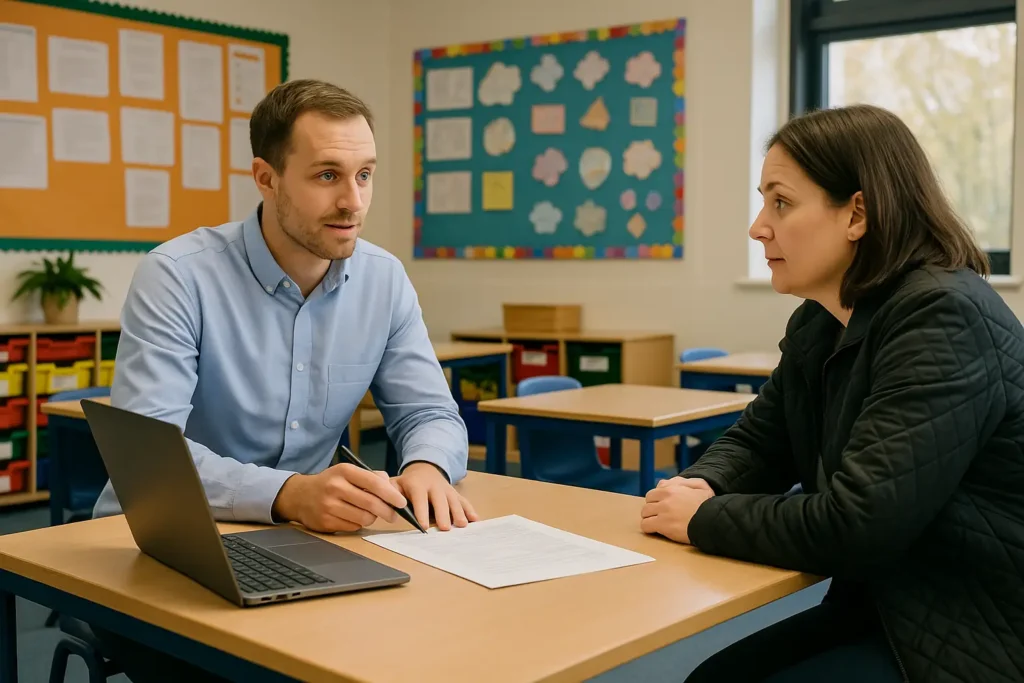You’ve prepped your lessons, ironed your shirt, and rehearsed your greeting. Then the bell rings, and suddenly you’re facing 30 students who don’t quite react the way you expected. Maybe they challenge your instructions with surprising boldness. Or maybe there’s a quiet sense that you’re out of sync with how things are done.
That’s the reality for many overseas teachers stepping into a UK classroom for the first time. However, through years of supporting international teachers, we’ve learnt what truly helps during those early days.
In this article, we’re sharing practical tips on teacher integration in UK schools, advice for managing your classroom with confidence, and the smaller cultural insights that rarely make it into official guides but make a real difference once you’re on the ground.
You’ll figure this out. Let’s get you sorted with confidence and clarity.
Getting to Know the UK School System
Look, we’ll be honest with you. The UK school system felt like learning a new language when we first started. There’s this whole structure that everyone assumes you just know, and once you get the hang of it, your daily life becomes so much easier. Trust us on this one.

Let us walk you through what we wish someone had told us from the start.
School Levels and Ages
UK education is divided into Key Stages. Primary includes Key Stages 1 and 2 (ages 5 to 11), while secondary covers Key Stages 3 and 4 (ages 11 to 16). After that, students usually move on to sixth form or college to complete A-levels or vocational qualifications until around age 18.
If you understand which Key Stage you’re working with, it helps you adjust your approach.
Curriculum Focus and Learning Objectives
The National Curriculum sets out what students should learn at each stage. It helps teachers plan accordingly with “learning intentions” and “success criteria” in mind.
The aim is to support learners to understand fundamental concepts clearly and apply them, rather than just memorise content.
Staff Roles and Day-to-Day Lingo
UK schools love their acronyms. SLT (Senior Leadership Team) are the people making big decisions about curriculum and behaviour. You’ll find them in meetings more than classrooms, but they’re not as scary as they seem.
TAs (Teaching Assistants) are absolute lifesavers who help with classroom learning and behaviour support. If you work with good TAs, your life becomes infinitely easier.
CPD (Continuing Professional Development) means training sessions. Some are truly useful, others… well, bring good coffee.
Students call teachers ‘Miss’ or ‘Sir’ regardless of their name or qualifications. Feels weird at first, but you’ll get used to it. It indeed creates nice classroom respect once you settle in.
Now that you’ve got the structure down, let’s look at how UK classrooms operate when it comes to behaviour and student expectations.
Classroom Behaviour Expectations
UK classroom behaviour follows a framework, which may sound simple on paper but takes practice to get right. According to this framework, students typically participate, ask questions, and work in groups. Meanwhile, schools lean heavily on policies to keep everything consistent and respectful.

Here’s how to approach behaviour management the UK way.
- The ‘friendly but firm’ tone: UK teachers master the calm-yet-approachable balance. You’ll probably overthink this at first since students need both respect and clear boundaries. Confidence in your tone helps you find this balance, and a consistent follow-through afterwards builds mutual respect.
- School-wide rules and reward systems: Most schools have whole-school behaviour policies that cover classroom rules, consequences, and rewards for positive choices. You’ll encounter house points, achievement certificates, and behaviour tracking charts. Maybe your school uses something different, but the principle stays the same.
- Student rights and how they affect classroom control: Safeguarding and inclusion are huge in UK schools, which means following fair processes when addressing behaviour. You need to be mindful of student well-being while still maintaining control.
If you can observe a few classes in your first week (even just 10 minutes here and there), do it. You’ll quickly pick up the tone, how transitions work, and what behaviour expectations look like in practice.
Watching experienced teachers handle the small moments teaches you more than any policy document ever will.
Teaching Style Adjustments
Teaching style adjustments sound fancy, but it’s really about adapting your lessons to UK school expectations. Learning habits, curriculum standards, and established teaching methods here all remarkably influence how you need to approach your classroom.
So here’s the thing: UK classrooms emphasise active learning with students questioning, discussing, and collaborating rather than passive listening. Teachers facilitate these interactions and continuously check understanding throughout lessons.
This often surprises overseas teachers (it certainly caught us off guard), but it reflects how much independence and participation matter here.
Student-Led Active Methods
Participation takes centre stage in this approach. Students explore ideas, share their thinking, and work together with classmates.
And instead of delivering long lectures, teachers often raise questions, introduce challenges, and facilitate group activities. In this way, students start to take more responsibility for their learning.
Assessment Styles and Feedback Expectations
The assessments in the UK education system involve having progress tracked through regular, informal checks. Teachers use questioning, quick tasks, and student self-assessments during lessons.
Written feedback is important here. Comments typically stress strengths and areas to improve, using phrases like “what went well” and “even better if.” You’ll write these so often they become automatic.
This approach supports growth without relying only on formal exams.
Differentiation and Use of Tech
Lessons are typically planned to support a range of abilities. You may adapt tasks to suit different learning needs within the same classroom. Schools also use digital tools such as smartboards, online platforms, and apps to support lessons and keep students engaged.
Managing Cultural Differences with Confidence
Cultural differences are basically any variation in values, communication styles, behaviour, or expectations between people from different backgrounds. In schools, these differences can influence everything, including classroom tone and staffroom etiquette.

You need to know about these differences to avoid misunderstandings and feel more at home.
Here are the ones you should look out for.
British Humour and Boundaries
Humour is part of daily life in UK classrooms, but the tone and timing can shock new teachers. It’s important to be able to read the room.
- Dry, sarcastic humour is common and often delivered with a straight face. It’s meant in fun, not as criticism. For example, when a student arrives late, you might deadpan “Good of you to join us” without any visible annoyance.
- Students may test boundaries using humour, especially with new teachers. They might tease lightly or joke back, and it’s often a sign of comfort instead of disrespect.
- You should keep your early interactions professional until you’re confident about how far the joking can go.
- Watch how local staff handle it. Their responses will give you a model for striking the right balance.
Staff Interactions and ‘Hidden’ Norms
Staffroom culture can feel polite but guarded at first. Many norms aren’t written down, but they do influence how teams operate.
- Small talk is the default. People chat about the weather, tea preferences, or weekend plans. It’s polite and inclusive, even if it feels surface-level at first.
- Sharing unspoken duties matters. If you use the last teabag or milk, replace it. If others stack mugs after break, follow suit.
- Staff meetings have their own rhythm. Don’t interrupt mid-flow. Wait until the end or raise a hand if invited to contribute.
- Politeness and patience are noticed. Respecting the flow of the room builds trust quickly.
Everyday Classroom Language Do’s and Don’ts
Language in UK classrooms is encouraging and usually understated. Tone, phrasing, and vocabulary determine how your message will land.
- Common phrases like “have a go,” “give it a try,” or “nearly there” encourage persistence without pressure.
- Sarcasm is best avoided until you’re sure it’s understood. What sounds playful to you may confuse or offend a student.
- Keep instructions calm and neutral. Raising your voice isn’t common. Pauses, eye contact, or proximity usually work better.
- Praise effort as well as outcome. Language like “good thinking” or “thanks for trying” is highly valued.
From our experience, teachers who adapt fastest are the ones who ask questions early. If something feels off, a quick check-in with a colleague saves weeks of second-guessing.
UK teams are usually happy to explain the unwritten rules when they see you’re really open to learning.
Building Connection: Students, Staff, and School Culture
Once you understand the cultural cues, your next step is to build meaningful relationships.
When you establish strong relationships with students and staff, you settle in faster, gain support, and create a more positive classroom environment. It also opens the door to guidance, growth, and the small wins that boost long-term confidence.
Here’s how to get started.
- Balance professionalism and warmth: Be approachable without being overly casual. Greet students by name, show interest in their progress, and maintain clear expectations. And with colleagues, be friendly, but respect boundaries and school routines.
- Find a mentor or buddy: Ask your head of department or team leader if there’s someone you can shadow or turn to with questions. Many schools pair new staff with a more experienced teacher, even informally. This is your opportunity to learn the ropes faster and feel less isolated.
- Take part in CPD (Continuing Professional Development): CPD workshops connect you with staff across the school, help you improve your teaching, and give insight into UK-specific strategies and expectations.
Quick tip: Making time for conversations with colleagues, even brief ones, can ease the transition and boost your confidence. Strong relationships often lead to better collaboration, more support, and a smoother experience throughout the school year.
Don’t Forget the Parents: Engaging Families in Your Journey
Parents play a major role in a child’s learning experience, and schools in the UK encourage regular, respectful communication between teachers and families. When you engage parents in your student’s learning process, it helps build trust, reinforce learning at home, and avoid misunderstandings.
This inclusion also shows that you care about the student as a whole person and not just their classroom performance.

Let’s see how you can involve parents in the learning process.
Parent Evening Protocols and Expectations
Parent-teacher meetings are usually brief, scheduled in blocks, and focused on progress, attitude, and areas to improve. It’s important to stay calm, clear, and constructive, especially when discussing concerns in these meetings. Avoid jargon and offer simple, practical next steps.
Email and Communication Tone
Written communication should be professional, polite, and easy to understand. UK schools value a calm, balanced tone. If there’s a concern, focus on facts and offer a positive way forward. Many teachers use templates to stay consistent.
Using School Platforms to Keep Parents Involved
Schools often use tools like ClassDojo, Seesaw, or SIMS to share updates, homework, or feedback. Familiarising yourself with these systems helps you stay connected with families and demonstrate involvement.
Go Beyond the Classroom: Integration Through Extracurriculars
In UK schools, integration means taking part in everyday school life beyond lessons. Joining in with activities, events, and informal moments helps you connect with students and staff, learn the school’s rhythm, and become part of the team.
These small efforts often lead to stronger relationships and a more rewarding teaching experience.
Here’s how to get involved in impactful ways:
- Club or sport involvement: Lunchtime clubs or after-school sports give you relaxed time with students outside formal lessons. This casual interaction builds trust naturally, and makes you more approachable while showing your colleagues that you’re invested.
- Social events for building relationships: When you attend school fairs, student performances, or staff socials, you get the chance to connect with others in a relaxed setting. Such informal interactions can lead to stronger collaboration during the school day and help you feel more at ease in the workplace.
- Small wins leading to long-term confidence: Volunteering for school trips or leading sessions makes you visible to colleagues, and visibility creates trust over time. This growing trust boosts your confidence and helps you feel truly a part of the community.
Extra-curricular involvement builds your support network and sense of belonging. Now that you’ve seen how to build strong relationships within the school community, let’s look at some practical tips for managing your transition with clarity and confidence.
Final Tips From Teachers Who’ve Been There
Learning from others who’ve made the move can make a positive impact. In this section, you’ll find tips that experienced international teachers often share after finding their rhythm in UK schools.
These tips are practical, honest, and grounded in real classroom experience. Each one is here to remind you that you’re not alone and that progress often starts with the small stuff.

Here’s what to focus on during your early days:
- Look for informal support: A quick chat over coffee or a friendly check-in at the photocopier often leads to useful advice and encouragement. Don’t be afraid to ask small questions. They usually open the door to the kind of practical help you won’t find in a handbook.
- Give yourself time to adjust: Feeling unsure at first is completely normal. Most teachers need a few weeks to settle into the pace, expectations, and routines. Keep showing up and permit yourself to learn as you go.
- Celebrate the wins: A good lesson, a breakthrough moment with a student, or a day that flows smoothly all count. Noticing them builds momentum and keeps your confidence growing.
Over time, we found that teachers who reflect often and stay open to feedback find their footing faster. Progress comes with consistency, and confidence builds one small step at a time.
Your Next Step Toward Teaching Success in the UK
Settling into a UK classroom takes time, but each part of the process brings you closer to feeling confident and capable in your new role. You’ve now explored how the school system works, what behaviour expectations look like, how to adjust your teaching style, and how to build meaningful connections with students, staff, and families.
The journey is smoother when you have the right tools. The Course Book offers expert resources, guides, and support designed for international teachers. If you are ready to take the next step with clarity and confidence, that is the place to start.
Equip yourself with the practical advice and insight you need to thrive in your UK teaching journey.
